What animals eat cabbage is a notion to worry about knowing that some of these animals specifically love to eat cabbage plants. These plants have a distinct smell and taste, which comes from a chemical compound known as mustard oil glycosides, that is contained in them.

It is this pungent smell that draws a good deal of cabbage eating animals and pests to the plant. This time frame gives many animals ample time to eat cabbage leaves. Some of the animals that are responsible for eating your vegetable’s leaves are listed below.
JUMP TO TOPIC
List of Animals That Eat Cabbage
1. Earth Fleas
Earth fleas are not typical fleas; they are beetles. The “flea” in their name refers to their strong flea-like jumping ability. These tiny insects have strong hind legs that help propel them away from a spot whenever they are frightened or disturbed. If you attempt to trap them, they will jump away. Earth fleas are usually solid black or other colors with yellow or black stripes.
– Characteristics
Earth fleas wreck a lot of damage to cabbage leaves. They move and attack in flocks; as a result, the damage can be severe, especially when they multiply. These pests come out in bulk during early spring and feed on the leaves of newly sprouted ones, leaving tiny holes on the them.
As a result of how tiny the fleas are, the holes their feeding causes appear like puncture holes from sewing needles.
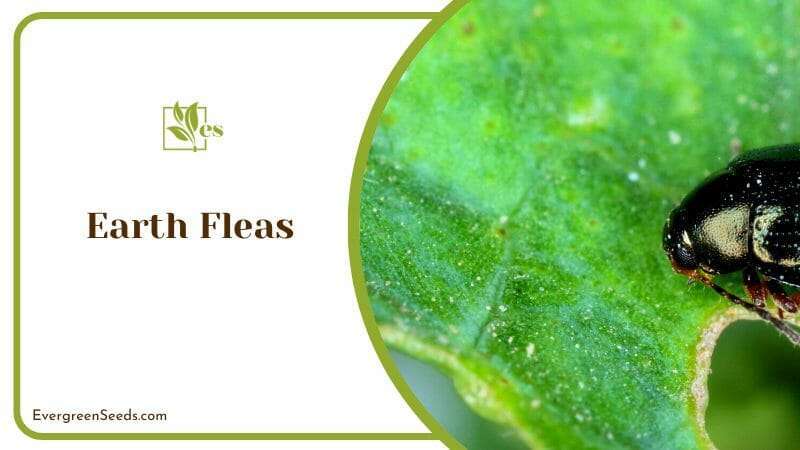
A severe earth flea infestation can destroy young plants; Older plants can still be salvaged because they’re more resistant to these pests. However, the holes they leave on cabbage leaves deform them and, in turn, devalue them.
– Control Methods
Prevention is better than cure, they say. It’s true. You save time and costs when you put things in place to prevent an infestation. There are things you can do to ensure that you don’t have to deal with an earth flea infestation. These pests prefer dry locations with little disturbance, so you need to do your best to make your garden as uncomfortable as possible for them.
One way to make these fleas uncomfortable is to water your cabbage plants regularly, ideally first thing in the morning so that they will feel annoyed and not approach. This action disturbs them and also creates an unconducive area for them. But when doing so, remember not to overwater the crops, and cause them stress.
Also, disturb the soil around younger plants occasionally to scare them away. On another note, you can take it a step further by sprinkling Diatomaceous Earth around your cabbage plants’ base. This powder is safe for plants, and it works to repel pesky pests.
2. Cabbage Aphids
There are numerous animals or pests that eat the vegetable’s leaves; aphids are one of them.
Aphids have several species, but the ones that feed on cabbage leaves are known as cabbage aphids, just as their name implies. These aphids are tiny green pests that have a gray-blue appearance.
Adult pests reproduce very quickly, and as a result they lay multiple eggs, which hatch and reach maturity in a very fast pace. Their rapid reproduction rate makes them very harmful pests, as they can quickly develop and take over your planted vegetable garden if they’re not controlled.
– Damage Caused
Aphids feed by sucking the nutrients from the leaves of the root vegetable. Their feeding action leaves the plants fragile and makes it easier for diseases and other pests to attack them. On the other hand, due to the way that they deplete the nutrients in cabbage leaves, they become weak, start to yellow, and eventually fall off.
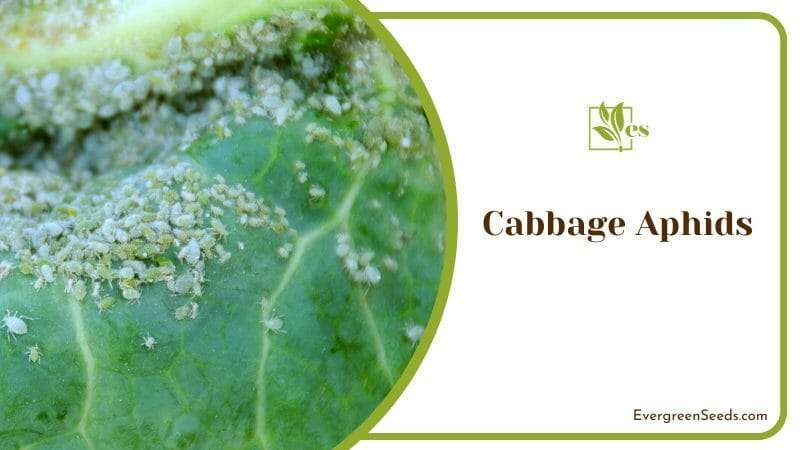
– Control Methods
If you notice a few aphids in your cabbage garden, you can quickly get rid of them by spraying them with water from a hose. The pressure of water from the hose knocks them off cabbage plants. However, if there are more aphids than you can control with only water, you can employ the help of some beneficial insects like lacewings, ladybugs, and earwigs to get rid of them.
Additionally, you can use a homemade miticide mixture of soap, Neem oil, and water to eradicate cabbage aphids, as these will be the solutions that would get rid of them very quickly.
All you need to do is put the mixture in a spray bottle and spray it all over your cabbage plants. Also, you can purchase some plant-safe pesticides from your local garden store. They are very effective in getting rid of these little aphids.
3. Snails
Snail farmers feed cabbage leaves to their snails as food. As a result, it’s no surprise that snails are pests in cabbage gardens where they are unwanted.
– Characteristics
These insects can cause severe damage to the plants when they feed on them, especially when there are many of them, or if they multiply. They have a reputation for quickly devouring large quantities of garden plants in very little time.
Snails become dormant during the dry season and only become active and reproductive when it starts to rain. Even at that, you will hardly find a snail out and about during the day, because they are prone to come at night time, or even first thing in the morning, when it’s much cooler, to eat.
As a result, nighttime or early morning is the best time to trap and eliminate them, as you will find them by the trace of slime that they leave when moving around, especially on this vegetable, it is quite easy because the surface is very smooth.
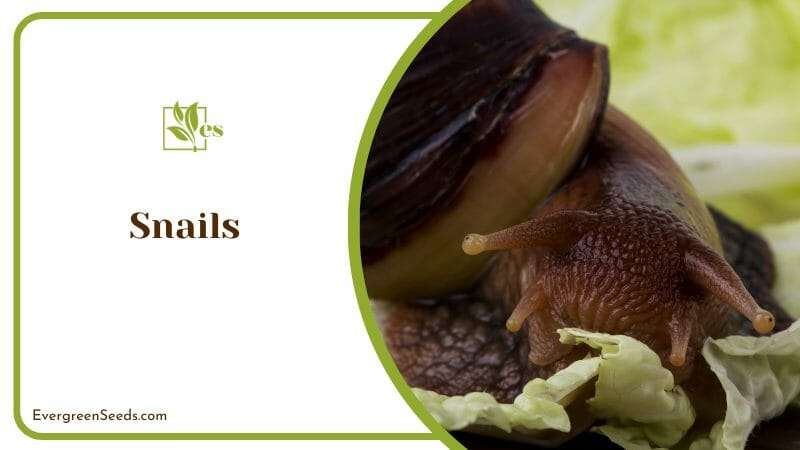
– Damage Caused
Snails can completely consume all the cabbage heads in your garden if they’re not quickly controlled, and as they multiply the job will be done even in a swifter manner. These pests eat the leaves, which causes the plants to become deformed and stunted. Due to these pests’ feeding, your cabbage leaves can also become yellow or brown.
– Control Methods
It’s best to handpick snails from your cabbage garden as you notice them. However, it’s impossible for you to handpick them all if you’re dealing with a severe snail infestation. One way to eliminate snails from your garden is by applying salt to the base of your cabbage plants, not too close, just around them.
Using salt sparingly is crucial because too much salt can harm your cabbage plants. Once snails come in contact with salt, they die, but as for the vegetable that you have planted, make sure that it is not directly on it because the excess would kill it.
Another way to get rid of snails is to grow plants that repel them around your garden, in addition, plants like fennel, rosemary, and anise help ward off these annoying pests. Also, many gardeners popularly use beer traps to get rid of snails. The smell of beer attracts snails, and when they get trapped in the beer container, they drown and eventually die, which is a very simple task.
4. Squirrels
You will find squirrels everywhere; in gardens, fields, and woods. Unlike the previously mentioned animals, squirrels are larger and very easy to spot among plants.
They have four strong legs that allow them to scurry about when they feel threatened or need to move about. These animals can be pests in gardens like cabbage gardens, where they’re unwanted.
– Characteristics
Squirrels enjoy gathering nuts and seeds, in parallel to this, these animals occasionally stumble into desirable garden areas while looking for a suitable spot to conceal and store the nuts and seeds they have collected.
Fruits and vegetables comprise a large portion of squirrels’ diets because they are primarily herbivores. Included in this group of vegetables are cabbage plants. As a result, it’s not out of place if you notice squirrels around cabbage plants.
Squirrels can wreak severe damage on your cabbages, of course, if they are not controlled. They are really intelligent and can be quick on their feet. As a result, it can be challenging to keep them at bay. Nevertheless, there are a few ways to do this.
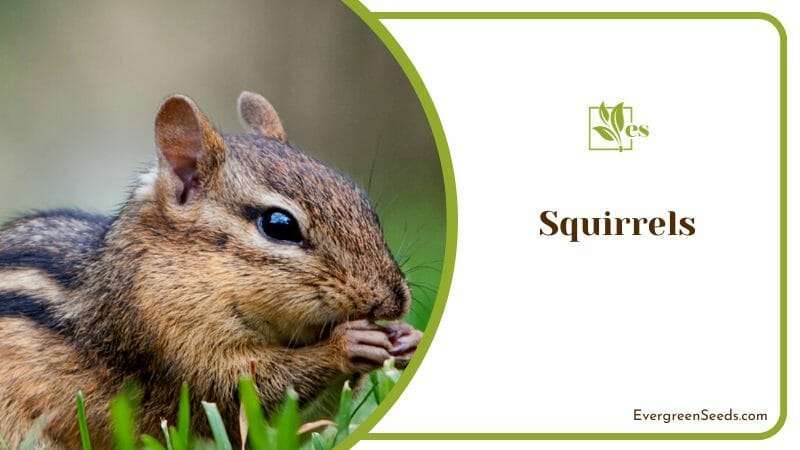
– Damage Caused
Squirrels are burrowing animals, so they dig holes in the garden soil. In the process of digging, they can displace and uproot plants or damage the roots in a severe way. These animals also eat cabbage leaves, likely leaving bite marks and the half-torn of their leaves are left behind. In feeding, squirrels can displace whole vegetables, leaving nothing behind for you to harvest.
– Control Methods
You can use a few tricks to repel squirrels, as they’re not very easy to catch. There are certain scents that these rodents hate. Smells, like peppermint oil and vinegar, are helpful in repelling squirrels, because they will be revolted by the aroma.
Keep these scents handy around your garden, and you won’t have squirrels sniffing around, and as a result, they will no longer come along your fence.
Also, you can trap them with fruits and nuts they like. Scatter the bait close to the trap to lure them. Even if you cannot trap them, baiting them like this will keep them distracted and away from your cabbage garden.
5. Worms
Several types of worms are attracted to and feed on your planted harvesting crops. Some of the most popular cabbage-eating worms are cabbage looper, imported worms, cutworms, cross-stripped cabbage worms, and diamondback moth larvae. All these pests have many things in common, one of which is their feeding habits.
– Characteristics
These pests have the potential to damage young cabbage plants, as well as mature ones, by munching on their leaves. Frequently, the damage they cause to cabbage leaves lowers their viability, and they will degenerate.
The smaller larvae are easier to manage and control, so it’s crucial to detect and identify them early to manage them properly. You will find most of these worms around the leaves and stems of the vegetable. Once you notice them, pick them off, or use any suitable control method.
– Damage Caused
When most of these worms attack, they feed off the plant’s leaves. Some, like cutworms, leave significant haphazard cuts on the leaves, causing the plant to look deformed. The damage caused can be extensive due to their large size, especially when there are many of them.
However, you should note that at times, this damage can lead to the eventual death of your plants completely.
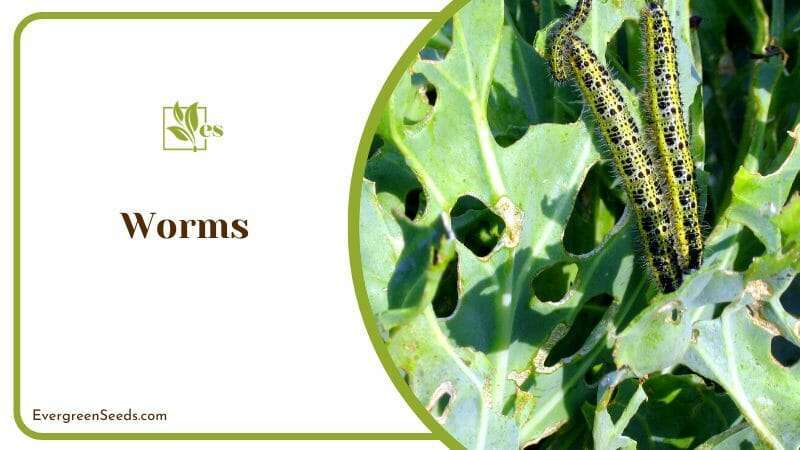
Some of these worms burrow holes in the leaves. The results are the same as those that cut out a large chunk of the leaves; the leaves look deformed and may eventually fall off and die. Also, some worm cause cabbage leaves to twist and fold, causing them to look deformed and lose market value.
– Control Methods
To control these tiny worms properly, you need first to identify the type of warm you’re dealing with, so you can know the kind of insecticides to use and when to use them. Identifying the species implicated in an infestation is critical since different worm species could respond differently to insecticides and other control methods.
You have two options if you notice a handful of worms, whatever type, in your vegetable garden. You can pick them up with your hand or spray them with water using a powerful pressure hose.
If you have a more severe infestation, rather than using just water, mix a little Neem oil and dish soap with the water, and spray your crops and plants thoroughly, so that they do not find other shelters from this crop one to other ones. Before using neem oil, make sure that it has not expired.
You should pay particular attention to the undersides of the leaves as well as the roots, the reason behind this is due to the fact that these pests and their larvae prefer to hide there.
You can repeat the process until your garden is clear of worms. You can also use plant-safe insecticides specifically targeted to eliminate worms that eat cabbages.
References
- Alina Bradford. (June 27, 2014). Squirrels: Diet, Habits & Other Facts. Live Science.
Retrieved from https://www.google.com/url?sa=t&source=web&rct=j&url=https://www.livescience.com/28182-squirrels.html&ved=2ahUKEwj6kYWBvOL7AhXZTKQEHSdQDxkQFnoECFIQAQ&usg=AOvVaw12xw1nGD8ZNWSb1s4jqqk9 - Ric Bessin. Cabbage Pests. University of Kentucky College of Agriculture.
Retrieved from https://entomology.ca.uky.edu/ef300#:~:text=Cutworms%2C%20imported%20cabbageworm%2C%20cabbage%20looper,feeding%20damage%20to%20older%20plants.












